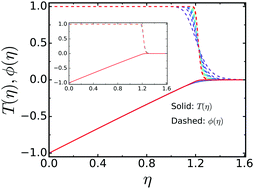Modeling polymer crystallisation induced by a moving heat sink
Abstract
Recent experimental work has shown that polymer crystallisation can be used to “move” and organize nanoparticles (NP). As a first effort at modeling this situation, we consider the classical Stefan problem but with the modification that polymer crystallisation does not occur at a single temperature. Rather, the rate of crystallisation is proportional to its subcooling, and here we employ a form inspired by the classical Avrami model to describe this functional form. Our results for the movement of the polymer crystallisation front, as defined as the point where the crystallinity is 50%, closely track the results of the classical Stefan problem. Thus, at this level of approximation, the crystallisation kinetics of the polymer do not cause qualitative changes to the physics of this situation. Inspired by this fact we study the more interesting situation where the directional recrystallisation of a polymer melt is considered, e.g., through the application of a moving heat sink over an initially molten polymer, reminiscent of a processing technique termed zone annealing. The polymer crystallisation shows that a steady state exists for a range of sink velocities. The solid–melt interface moves slightly ahead of the sink but at the same velocity. The steady-state distance between the sink and the interface decreases with increasing sink velocity – this is a consequence of the excess cooling provided by the sink over what is required to crystallise the melt. The most interesting new result is that the temperature of the crystal–melt interface decreases with increasing sink velocity. This is in line with the ansatz of Lovinger and Gryte who suggested that larger zone annealing velocities correspond to progressively larger effective undercoolings at which polymer crystallisation occurs.



 Please wait while we load your content...
Please wait while we load your content...